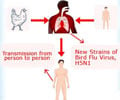Bats don't only carry the fatal Ebola virus, but also is a reservoir for a new type of influenza virus which could possibly attack the cells of humans and livestock.

TOP INSIGHT
Novel influenza viruses have the potential to infect both humans and livestock. The bat influenza viruses connect to a cell receptor that is present in various species, and raise potential risk to humans.
About six years ago, a new kind of influenza virus was discovered in bats in South America. The flying mammals have been the focus of virologists for a long time already. This is because they carry many different kinds of viruses, including lethal ones such as the Ebola virus. However, it has previously been unclear whether bat influenza viruses also present a threat to humans. An international research team led by the University of Zurich (UZH) has now discovered that these new influenza viruses have the potential to also infect humans and livestock.
Global search for "entry gate"
Previously known influenza viruses bind to host cells via sialic acids. These groups of chemicals can be found on the surface of almost all human cells and in various animals. This is one of the reasons why influenza viruses can infect species that are very different from one another, such as ducks, chickens, pigs, and humans. Unlike these viruses, the bat influenza viruses don’t bind to sialic acids, which is why several research teams all over the world started searching for the receptor through which they enter human cells.
Bat viruses use MHC-II molecule to enter cell
Potential risk for humans and livestock
"Such an infection has not yet been observed. However, our findings show that the viruses generally have this zoonotic potential," adds Silke Stertz. This is reason enough for the UZH virologist to continue researching the potentially dangerous viruses, not least since due to migration and travel the problem is not restricted to South America.
Source-Eurekalert
 MEDINDIA
MEDINDIA




 Email
Email










